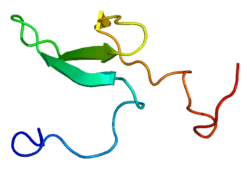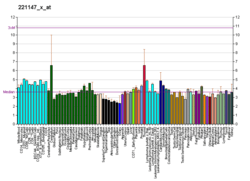WWOX
WW domain-containing oxidoreductase is an enzyme that in humans is encoded by the WWOX gene.[5][6][7][8]
Function
WW domain-containing proteins are found in all eukaryotes and play an important role in the regulation of a wide variety of cellular functions such as protein degradation, transcription, and RNA splicing. This gene encodes a protein which contains 2 WW domains and a short-chain dehydrogenase/reductase domain (SRD). The highest normal expression of this gene is detected in hormonally regulated tissues such as testis, ovary, and prostate. This expression pattern and the presence of an SRD domain suggest a role for this gene in steroid metabolism. The encoded protein is more than 90% identical to the mouse protein, which is an essential mediator of tumor necrosis factor-alpha-induced apoptosis, suggesting a similar, important role in apoptosis for the human protein. In addition, there is evidence that this gene behaves as a suppressor of tumor growth. Alternative splicing of this gene generates transcript variants that encode different isoforms.[8]
WWOX is also known as human accelerated region 6. It may, therefore, have played a key role in differentiating humans from apes.[9]
Interactions
WWOX has been shown to interact with P53 and ACK1.[10][11]
References
- GRCh38: Ensembl release 89: ENSG00000186153 - Ensembl, May 2017
- GRCm38: Ensembl release 89: ENSMUSG00000004637 - Ensembl, May 2017
- "Human PubMed Reference:". National Center for Biotechnology Information, U.S. National Library of Medicine.
- "Mouse PubMed Reference:". National Center for Biotechnology Information, U.S. National Library of Medicine.
- Bednarek AK, Laflin KJ, Daniel RL, Liao Q, Hawkins KA, Aldaz CM (May 2000). "WWOX, a novel WW domain-containing protein mapping to human chromosome 16q23.3-24.1, a region frequently affected in breast cancer". Cancer Res. 60 (8): 2140–5. PMID 10786676.
- Ried K, Finnis M, Hobson L, Mangelsdorf M, Dayan S, Nancarrow JK, Woollatt E, Kremmidiotis G, Gardner A, Venter D, Baker E, Richards RI (Sep 2000). "Common chromosomal fragile site FRA16D sequence: identification of the FOR gene spanning FRA16D and homozygous deletions and translocation breakpoints in cancer cells". Hum Mol Genet. 9 (11): 1651–63. doi:10.1093/hmg/9.11.1651. PMID 10861292.
- Persson B, Kallberg Y, Bray JE, Bruford E, Dellaporta SL, Favia AD, Duarte RG, Jörnvall H, Kavanagh KL, Kedishvili N, Kisiela M, Maser E, Mindnich R, Orchard S, Penning TM, Thornton JM, Adamski J, Oppermann U (Feb 2009). "The SDR (Short-Chain Dehydrogenase/Reductase and Related Enzymes) Nomenclature Initiative". Chem Biol Interact. 178 (1–3): 94–8. doi:10.1016/j.cbi.2008.10.040. PMC 2896744. PMID 19027726.
- "Entrez Gene: WWOX WW domain containing oxidoreductase".
- Pollard KS, Salama SR, Lambert N, Lambot MA, Coppens S, Pedersen JS, Katzman S, King B, Onodera C, Siepel A, Kern AD, Dehay C, Igel H, Ares M, Vanderhaeghen P, Haussler D (2006-08-16). "An RNA gene expressed during cortical development evolved rapidly in humans". Nature. 443 (7108): 167–72. doi:10.1038/nature05113. PMID 16915236. supplement
- Chang NS, Pratt N, Heath J, Schultz L, Sleve D, Carey GB, Zevotek N (February 2001). "Hyaluronidase induction of a WW domain-containing oxidoreductase that enhances tumor necrosis factor cytotoxicity". J. Biol. Chem. 276 (5): 3361–70. doi:10.1074/jbc.M007140200. PMID 11058590.
- Mahajan NP, Whang YE, Mohler JL, Earp HS (November 2005). "Activated tyrosine kinase Ack1 promotes prostate tumorigenesis: role of Ack1 in polyubiquitination of tumor suppressor Wwox". Cancer Res. 65 (22): 10514–23. CiteSeerX 10.1.1.322.9333. doi:10.1158/0008-5472.can-05-1127. PMID 16288044.
Further reading
- Ramos D, Aldaz CM (2007). WWOX, a chromosomal fragile site gene and its role in cancer. Adv. Exp. Med. Biol. Advances in Experimental Medicine and Biology. 587. pp. 149–59. doi:10.1007/978-1-4020-5133-3_14. ISBN 978-1-4020-4966-8. PMID 17163164.
- Chang NS, Pratt N, Heath J, Schultz L, Sleve D, Carey GB, Zevotek N (2001). "Hyaluronidase induction of a WW domain-containing oxidoreductase that enhances tumor necrosis factor cytotoxicity". J. Biol. Chem. 276 (5): 3361–70. doi:10.1074/jbc.M007140200. PMID 11058590.
- Paige AJ, Taylor KJ, Taylor C, Hillier SG, Farrington S, Scott D, Porteous DJ, Smyth JF, Gabra H, Watson JE (2001). "WWOX: A candidate tumor suppressor gene involved in multiple tumor types". Proc. Natl. Acad. Sci. U.S.A. 98 (20): 11417–22. doi:10.1073/pnas.191175898. PMC 58744. PMID 11572989.
- Bednarek AK, Keck-Waggoner CL, Daniel RL, Laflin KJ, Bergsagel PL, Kiguchi K, Brenner AJ, Aldaz CM (2001). "WWOX, the FRA16D gene, behaves as a suppressor of tumor growth". Cancer Res. 61 (22): 8068–73. PMID 11719429.
- Kuroki T, Trapasso F, Shiraishi T, Alder H, Mimori K, Mori M, Croce CM (2002). "Genetic alterations of the tumor suppressor gene WWOX in esophageal squamous cell carcinoma". Cancer Res. 62 (8): 2258–60. PMID 11956080.
- Chang NS, Doherty J, Ensign A (2003). "JNK1 physically interacts with WW domain-containing oxidoreductase (WOX1) and inhibits WOX1-mediated apoptosis". J. Biol. Chem. 278 (11): 9195–202. doi:10.1074/jbc.M208373200. PMID 12514174.
- Ludes-Meyers JH, Bednarek AK, Popescu NC, Bedford M, Aldaz CM (2004). "WWOX, the common chromosomal fragile site, FRA16D, cancer gene". Cytogenet. Genome Res. 100 (1–4): 101–10. doi:10.1159/000072844. PMC 4150470. PMID 14526170.
- Watanabe A, Hippo Y, Taniguchi H, Iwanari H, Yashiro M, Hirakawa K, Kodama T, Aburatani H (2004). "An opposing view on WWOX protein function as a tumor suppressor". Cancer Res. 63 (24): 8629–33. PMID 14695174.
- Chen ST, Chuang JI, Wang JP, Tsai MS, Li H, Chang NS (2004). "Expression of WW domain-containing oxidoreductase WOX1 in the developing murine nervous system". Neuroscience. 124 (4): 831–9. doi:10.1016/j.neuroscience.2003.12.036. PMID 15026124.
- Ishii H, Mimori K, Vecchione A, Sutheesophon K, Fujiwara T, Mori M, Furukawa Y (2004). "Effect of exogenous E2F-1 on the expression of common chromosome fragile site genes, FHIT and WWOX". Biochem. Biophys. Res. Commun. 316 (4): 1088–93. doi:10.1016/j.bbrc.2004.02.159. PMID 15044096.
- Ludes-Meyers JH, Kil H, Bednarek AK, Drake J, Bedford MT, Aldaz CM (2004). "WWOX binds the specific proline-rich ligand PPXY: identification of candidate interacting proteins". Oncogene. 23 (29): 5049–55. doi:10.1038/sj.onc.1207680. PMC 4143251. PMID 15064722.
- Aqeilan RI, Pekarsky Y, Herrero JJ, Palamarchuk A, Letofsky J, Druck T, Trapasso F, Han SY, Melino G, Huebner K, Croce CM (2004). "Functional association between Wwox tumor suppressor protein and p73, a p53 homolog". Proc. Natl. Acad. Sci. U.S.A. 101 (13): 4401–6. doi:10.1073/pnas.0400805101. PMC 384759. PMID 15070730.
- Kuroki T, Yendamuri S, Trapasso F, Matsuyama A, Aqeilan RI, Alder H, Rattan S, Cesari R, Nolli ML, Williams NN, Mori M, Kanematsu T, Croce CM (2004). "The tumor suppressor gene WWOX at FRA16D is involved in pancreatic carcinogenesis". Clin. Cancer Res. 10 (7): 2459–65. doi:10.1158/1078-0432.CCR-03-0096. PMID 15073125.
- Guler G, Uner A, Guler N, Han SY, Iliopoulos D, Hauck WW, McCue P, Huebner K (2004). "The fragile genes FHIT and WWOX are inactivated coordinately in invasive breast carcinoma". Cancer. 100 (8): 1605–14. doi:10.1002/cncr.20137. PMID 15073846.
- Sze CI, Su M, Pugazhenthi S, Jambal P, Hsu LJ, Heath J, Schultz L, Chang NS (2004). "Down-regulation of WW domain-containing oxidoreductase induces Tau phosphorylation in vitro. A potential role in Alzheimer's disease". J. Biol. Chem. 279 (29): 30498–506. doi:10.1074/jbc.M401399200. PMID 15126504.
- Aqeilan RI, Kuroki T, Pekarsky Y, Albagha O, Trapasso F, Baffa R, Huebner K, Edmonds P, Croce CM (2004). "Loss of WWOX expression in gastric carcinoma". Clin. Cancer Res. 10 (9): 3053–8. doi:10.1158/1078-0432.CCR-03-0594. PMID 15131042.
- Park SW, Ludes-Meyers J, Zimonjic DB, Durkin ME, Popescu NC, Aldaz CM (2004). "Frequent downregulation and loss of WWOX gene expression in human hepatocellular carcinoma". Br. J. Cancer. 91 (4): 753–9. doi:10.1038/sj.bjc.6602023. PMC 2364795. PMID 15266310.






